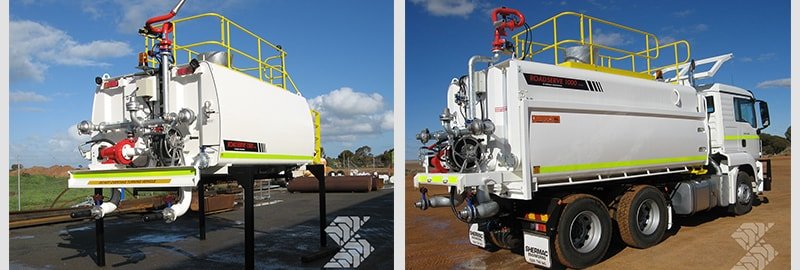
Whether you need to store water, fuel, or any other chemical, it is important to know which type of tank best suits your needs. Tanks come made in a multitude of materials, in this article we compare steel, fibreglass, and polyethylene, each with their own benefits and weaknesses. At Shermac, we primarily use steel tanks for all of our vehicles.
Deciding which tank is appropriate for your needs can be an overwhelming and confusing task. Reliability, budget, maintenance, and sturdiness are all factors that come into play when deciding the material of a tank.
Below is a quick guide to some of the advantages and disadvantages between steel, poly, and fibreglass tanks.

Steel tanks are highly durable and reliable. The strong surface makes them difficult to puncture or damage, with steel being easy to manipulate into any shape or size. This is a key factor as to why Shermac use steel tanks. Not only will they survive in the harsh conditions experienced on site, they will withstand increases in temperature and perform better than poly and fibreglass against fire.
At Shermac we manufacture all of our steel tanks onsite, blasting and painting them using a quality two-pack paint system internally and externally, with corrosion protection systems available for operation in corrosive site conditions.
Steel tanks, however, are much heavier than polyethylene and fibreglass tanks, increasing transport and installation costs. Over time, galvanised steel will rust and corrode if not properly maintained. If used for water storage, zinc may eventually leak into the water leaving a metallic taste.

Polyethylene tanks are generally one of two types; fabricated or moulded.
Fabricated polyethylene tanks are mostly manufactured from flat sheets of high density polyethylene (HDPE). The construction methodology of fabricated tanks is similar to steel tanks, with the sheets being welded together with the use of specialised equipment to form a base, sides, and roof, to the required dimensions.
Generally, fabricated poly tanks require more baffles than a stainless steel or aluminium tank, which can cause issues with larger holding tanks. Another downside is the fact that the manufacturing process is very specialised. This has an effect on their availability and increases their price.
Moulded polyethylene tanks are rotationally moulded from low density polyethylene (LDPE), resulting in a single piece construction, which reduces any weaknesses that may occur in the seams, while at the same time decreasing any risk of leaks.
Both LDPE and HDPE tanks are generally lighter in weight than steel, with polyethylene able to sustain a reasonable hit without deforming or rupturing.
Cons associated with moulded LDPE tanks are the fact that they suffer from discolouration when used for diesel storage and tend to fatigue quicker than steel when used in high duty cycle situations.
Customisation of LDPE tanks can also be quite expensive. Custom moulds need to be manufactured, which can be quite time consuming for manufacturers who may be unwilling to do so as there might not be sufficient enough market for them to recoup this cost.
Another disadvantage to using LDPE is the limited baffle options available for moulded tanks. This poses a problem with liquid surge in larger cartage tanks, affecting both the durability of the tank and the carrying vehicle safety. Moulded LDPE tanks, similar to fibreglass tanks, are also prone to algal growth due to allowing more light penetration than HDPE or steel.
While poly tanks are recyclable at the end of their lifecycle, they pose a higher risk of failure in a fire (you can penetrate a PE tank with a cigarette lighter), or extreme temperatures.
Some of the advantages of using HDPE and LDPE poly tanks include the fact they are resistant to most chemicals and corrosion. Their single piece constructs provide strength and durability, giving the tanks the ability to withstand harsh conditions.
While less popular and harder to find than poly and steel tanks, fibreglass tanks offer greater heat protection and are resistant to rust and chemical corrosion. They are available in multiple sizes and are able to be placed above or below ground.
With the manufacturing process for fibreglass tanks being more time consuming, this results in a higher price than an equivalent tank constructed from steel or poly.
When used for water storage, fibreglass tanks are prone to algal growth due to allowing more light penetration that steel or HDPE poly tanks. The brittle construct of these types of tanks also makes them less appealing than steel or poly as they are prone to crack easily.
Shermac are here to help!
When consulting with our clients, it is important that all advantages and disadvantages of tank design and material are discussed. All of our products are rigorously tested to ensure they perform at the peak of their ability.
For more information about the type of tank that will best suit your needs, call us today on 1300 799 943, we are here to help.
Talk to our well-trained and knowledgeable team to find out more about our customisation process and how we can help you.
Call our team on 1300 799 943 or email [email protected] with your inquiry.